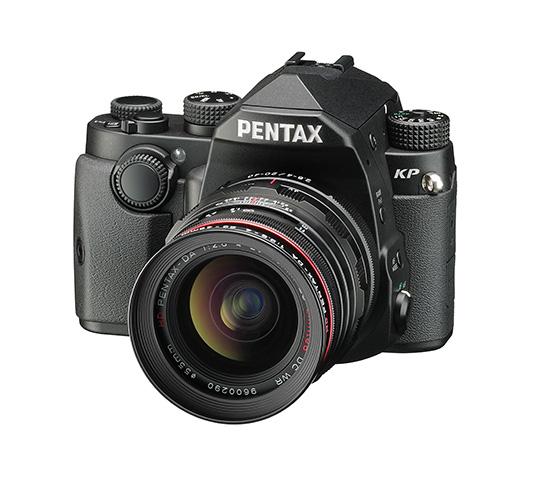Ricoh just took the wraps off the Pentax KP, a rather compact magnesium alloy body DSLR with a 5-stop, 5 axis stabilisation system and ISO 819,200. The body is not particularly beautiful, but inside it waits a noise reduction co-processor that, by first appearances, rivals DxO’s PRIME software, but acts instantaneously. (If you’ve used DxO’s engine, you’ll know what I’m talking about.)

(Source: Ricoh promotional materials)
Technical expose: High ISO images are noisier on average than low ISO ones. The noise cannot be neatly compressed, increases file size and slows down the process of writing files to storage (SD card in most cases). This can affect frame rates. In order to keep the frame rate up, Pentax used to apply noise reduction in RAW from ISO 3200 (several models including at least the K-5, K-5 II, K-5 IIs, K-30 and K-50). This was not configurable and led to mushy images that did not respond well to further noise reduction using other methods. So the way to work with these cameras was to underexpose ISO 1600 by up to three stops, depending on your need – not the best idea if you want to maximise colour tonality, but it got the job done.

the accelerator unit.
(Source: Ricoh promotional materials)
But from samples I’ve seen, the new co-processor, dubbed in the latest press release a “state-of-the-art accelerator unit”, renders such concerns obsolete. In the samples, ISO 6400 looks rather clean, and I’m curious to take a closer look at ISO 12,800. Several in the Pentax community have commented that they might delay their entry into full frame based on this camera’s performance, so the pressure is on for Pentax to bring the accelerator unit and high ISO performance to an updated K-1 full frame camera.

in Live View
(Source: Ricoh promotional materials)
Launch price for the Pentax KP is going to be 1100 Euros/Dollars; the Pentax K-70 with similar performance up to ISO 102,400 (also has accelerator unit) is about 400 Euros/Dollars cheaper.

(Source: Ricoh promotional materials)
Conclusion: The Pentax KP’s combination of five stops of stabilisation with state-of-the-art in-camera noise reduction will save you money on bodies, lenses, and software, as Pentax leapfrogs the competition. Bring on the night!
For more:
[…] is an ISO 819,200 shot from Ricoh’s promotional materials for the Pentax KP, with light post processing from JPEG applied by the breakfastographer. Click on the image to […]
[…] Feel free to head over to Imaging-Resource for more samples, or take a look at a comparison of the K-70 and Nikon D500 at ISO 102,400, or the post-processed ISO 800k result from a night-time Pentax KP out-of-camera JPEG. Alternatively, read my overall thoughts on the Pentax KP. […]
Please have the noise compare kp / k-70 at 800 and 1600 Iso? Unfortunately Dxomark does not tested the kp.Many thanks
Hallo Antonio, thanks for your comment. You will find samples at Imaging-Resource or DPReview. They will not include any additional noise reduction using DxO PRIME, though, like I did in some of my tests. ISO 800 and 1600 images should be fairly clean, though, so running PRIME might be overkill. I suppose there’s room for a really comprehensive comparison – if I have time and readership. 😉 All the best!
[…] Due to the added noise control by way of the Accelerator Unit, the highest available sensitivity has been increased to ISO 819,200 – I previously reviewed this high ISO using samples for the Pentax KP. […]
[…] My overall thoughts on the Pentax KP […]
[…] Coverage of the original Pentax KP launch. […]
[…] reminds me a little of the Pentax KP with its interchangeable […]
[…] As with the recently announced Olympus OM-D E-M5 III, there is an accessory that adds more depth to the X-Pro3’s grip, but without replicating the shutter button (so more like the grips on a Pentax KP): […]
[…] “Extract edge” as it appears on a Pentax KP […]